Andrew J. Martin
Postdoctoral Fellow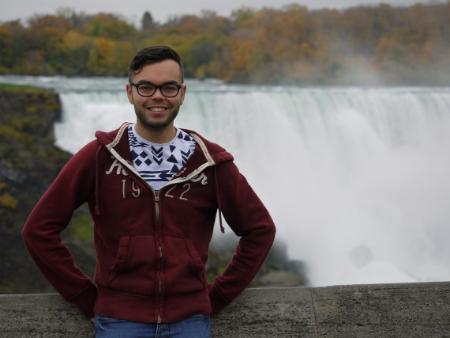
As part of the Jamieson Marine Mineral Resources group, my research focuses on seafloor massive sulfide (SMS) deposits and their ancient on-land analogues, volcanogenic massive sulfide (VMS) deposits. These deposits are actively forming today on the seafloor as ‘black smoker’ hydrothermal vent fields. Globally, ancient VMS deposits are important sources of base (Cu, Pb and Zn) and critical metals used in green technologies (Te, Se, Ge). My research focuses on understanding metal enrichment processes in active and ancient VMS systems and how these processes vary with tectonic environment and the maturity of the hydrothermal field (i.e. change over time). To investigate this, I principally focus on observations made at the mineral-scale, utilising the in situ analysis of sulfide minerals. These minerals record temporal variations in fluid physicochemistry during deposit formation. I am especially interested in tracing magmatic volatile influx in VMS systems and the influence this has on the metal budget of a hydrothermal system.
My main research interests are:
• Mineral scale partitioning and distribution of trace elements in hydrothermal sulfides
• Tracing magmatic volatile influx in active and ancient VMS systems
• Comparing active and ancient VMS systems
• Trace element and sulfur isotope systematics of active VMS systems
• Reflected light microscopy of sulfides
My research previously focused on ancient on-land VMS analogues, principally the Troodos ophiolite of Cyprus where I undertook my PhD research, titled: “Tellurium (Te) and selenium (Se) in mafic volcanogenic massive sulfide hydrothermal systems: evidence from the Troodos ophiolite, Cyprus” (Cardiff University, UK). Regional sampling of >20 Troodos VMS deposits and subsequent bulk rock geochemical and sulfur isotope analysis was used to identify regional variations in magmatic volatile influx between different VMS deposits. Additionally, Laser Ablation Inductively Coupled Plasma Mass Spectrometry (LA-ICP-MS) of sulfides was used to characterise the incorporation (i.e. mineral/nano-scale inclusions vs. solid solution), partitioning and enrichment of trace elements between different sulfide minerals. My PhD research led to the development of a new regional ore-forming model for the Troodos ophiolite and has implications for the source of metals in the wider mafic VMS environment.
I also have experience working with active seafloor analogues; in 2018 I sailed as an Alteration Mineralogist on the International Ocean Discovery Program (IODP) Expedition 376 “Brothers Arc Flux”. The aim of the expedition was to compare and contrast ‘magmatic’ and ‘seawater’ dominated hydrothermal systems located within the active Brothers Caldera (Kermadec Arc, New Zealanad). My duties included core logging, detailed mineralogical characterisation of samples in reflected and transmitted light and report writing. My ongoing post cruise research utilises Scanning Electron Microscopy (SEM) element mapping, LA-ICP-MS of pyrite, Secondary Ion Mass Spectrometry (SIMS) and X-ray Diffraction to investigate the influence of a variable magmatic volatile influx between contrasting hydrothermal vent sites.
Please don’t hesitate to contact me for further information or future collaborations.
See more about my time at sea: https://www.youtube.com/watch?v=mvtb4myL0us
Check out my latest research and publications:
Twitter: @ajmartin1991
ResearchGate: https://www.researchgate.net/profile/Andrew_Martin40
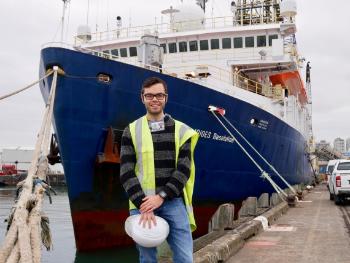
The R/V JOIDES Resolution docked in Auckland, New Zealand after two months at sea.
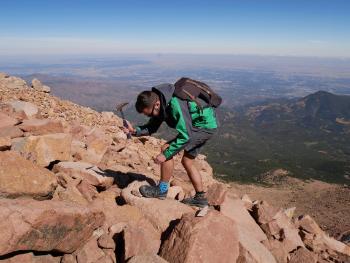
Collecting samples at Pikes Peak Colorado.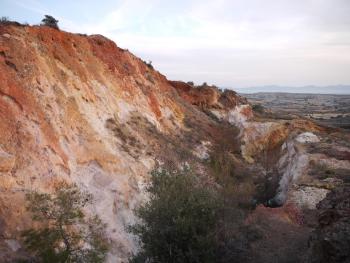
An example of Au-rich mineralisation in Troodos, Cyprus.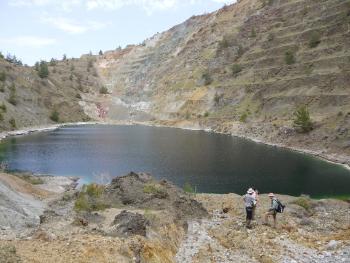
A typical open-pit abandoned VMS mine in Troodos, Cyprus.